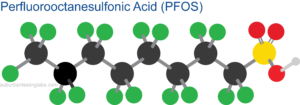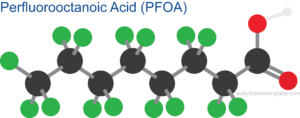PFAS Now
Every day PFAS exposure comes from many sources, including drinking contaminated water, eating fish from contaminated waterways, inhaling dust or soil, eating food packaged with PFAS materials, and exposure to consumer products with PFAS like non-stick cookware, stain-resistant carpets, and water-repellent clothing.2
PFAS contamination has been linked to numerous health concerns in humans, including kidney cancer, testicular cancer, thyroid disease, liver damage, pregnancy-induced preeclampsia, and immune dysfunctions.5
We are starting to see PFAS laws taking shape in many states. There has been significant public pressure on lawmakers to prioritize and fast-track PFAS regulations to understand and reduce this harmful exposure.
- Drinking Water PFAS Testing
- Non-Potable Water, Wastewater, Groundwater PFAS Testing
- EPA’s UCMR5 Drinking Water Testing
- Private Well Testing for PFAS
PFAS – A History
 PFOA, known as the “forever chemical,” was first produced by 3M in 1947, and in 1951 DuPont started using it to make Teflon. In 1953, PFOS was unintentionally spilled on the shoe of a chemist at 3M in 1953. As a result, they concluded that this coating repels oil and water and the creation of “Scotchgard” was born.
PFOA, known as the “forever chemical,” was first produced by 3M in 1947, and in 1951 DuPont started using it to make Teflon. In 1953, PFOS was unintentionally spilled on the shoe of a chemist at 3M in 1953. As a result, they concluded that this coating repels oil and water and the creation of “Scotchgard” was born.
A firefighting foam containing PFOA and PFOS was developed in the 1960’s by 3M and the US Navy. In the 1970s various airports, military sites, and firefighters began using the product. Around this same time, it was discovered that PFAS was toxic to animals and humans.
 In the 1980’s the US Navy discovered these contaminants are harmful to aquatic life, and 3M proved employees had PFAS detections in their blood. DuPont discovered PFOA could pass from mother to unborn baby.
In the 1980’s the US Navy discovered these contaminants are harmful to aquatic life, and 3M proved employees had PFAS detections in their blood. DuPont discovered PFOA could pass from mother to unborn baby.
In 1999 the battle against the use and manufacturing of these chemicals began. The USEPA and 3M found PFOS contamination in blood banks. A farmer in West Virginia sued DuPont after his cattle mysteriously died near a DuPont plant where tons of PFOS were dumped into a local landfill. This disposal polluted the Ohio River and the drinking water supply for more than 80,000 people. The spotlight was on the manufacturers to do better to protect public health.
In 2000, 3M stopped production of PFOA and PFOS but started creating new “short-chain” PFAS formulations. The industry believed these PFAS compounds to be safer. “Long-chain” and “short-chain” refer to the number of fluorine atoms in the compounds.4
EPA established PFOA was a carcinogen in 2005, and the next year EPA encouraged all manufactures to stop making long-chain PFAS. DuPont agreed but started making short-chain varieties.
FDA studies showed that short-chain PFAS can accumulate in the liver, fat, and plasma of rats, and persist for half of their lifespan.4
 Since 2009 the EPA has been working to implement limits of PFAS in drinking water. Forms of PFAS are estimated to be present in the blood of 98% of Americans, detected at many military sites, and present in hundreds of drinking water supplies in excess of EPA’s health advisory.
Since 2009 the EPA has been working to implement limits of PFAS in drinking water. Forms of PFAS are estimated to be present in the blood of 98% of Americans, detected at many military sites, and present in hundreds of drinking water supplies in excess of EPA’s health advisory.
PFAS is referred to as a “forever chemical” because they do not break down in the environment, and bioaccumulate in humans. Scientists estimate it could take hundreds, or even thousands, of years to break down in the environment naturally.5
Testing for PFAS Contamination
There are few Laboratories performing PFAS analysis in Pennsylvania, New Jersey, Maryland, and Delaware. However, Suburban Testing Labs is your trusted resource for all PFAS testing for drinking water and wastewater at our laboratory in Reading, PA. Your analysis will be handled right at our headquarters without the need to ship samples to an out-of-state facility. You can have peace of mind knowing your samples will be handled locally by trusted professionals.
Contact us for PFAS testing on your Drinking Water and Wastewater today. Click on the buttons below to learn more.
Sources:
1 – https://www.santafenewmexican.com/news/local_news/toxic-timeline-a-brief-history-of-pfas/article_20609664-48c7-574e-a9f7-1fb813e9a13e.html
2 – https://health.hawaii.gov/heer/environmental-health/highlighted-projects/per-and-polyfluoroalkyl-substances-pfass/
3- https://www.epa.gov/dwucmr/fifth-unregulated-contaminant-monitoring-rule
4- https://www.ewg.org/news-insights/news/fda-studies-short-chain-pfas-chemicals-more-toxic-previously-thought
5- https://www.scientificamerican.com/article/forever-chemicals-are-widespread-in-u-s-drinking-water/
